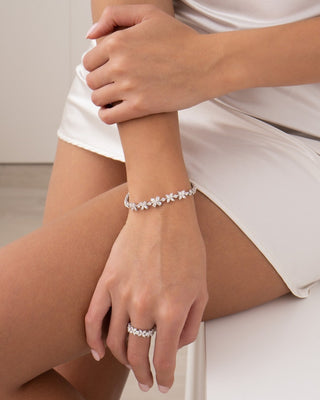Education on diamonds
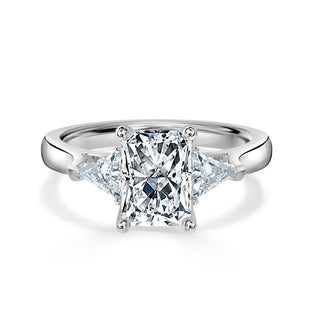
The 4 C's of Diamonds: Assessing Diamond Quality
The 4 Cs – cut, color, clarity, and carat – serve as the universally recognized standards for evaluating a diamond's quality and value. While each of these 'Cs' carries significance, cut stands out as the most pivotal in determining a diamond's brilliance and sparkle. Striking the right balance among these four key aspects is essential when searching for a diamond that combines beauty and value.
Understanding the 4 C's of Diamonds
These four attributes are the fundamental factors that influence the beauty and structural integrity of a diamond. The 4 Cs are interconnected within the diamond, shaping its appearance and overall quality. For instance, the diamond's capacity to reflect light into your eyes is primarily determined by the quality of the cut but is also influenced by color and clarity. (The debate between diamond clarity and color is a common question among many buyers; read on to ascertain which one holds greater importance.)
Professional graders use a consistent scale to evaluate each of the four diamond characteristics, providing a reliable tool for assessing diamonds. By scrutinizing the 4 Cs of a particular diamond, you can gain a better understanding of its quality. The Gemological Institute of America (GIA) elaborates on why and how diamond grades were established.
The Characteristics of Diamonds
The GIA is a renowned institution with a sophisticated grading system for assessing diamond attributes. It is widely considered the most reliable entity, and obtaining a diamond certificate from the GIA is highly recommended. Each of the 'Cs' is graded on a scale, allowing for quality assessment. While there exists some universal terminology and standard grading, it's important to note that grading may vary slightly between different lab entities.
The gradings of the 4 Cs play a crucial role in determining a diamond's value and indicating its quality. Many diamond sellers base their prices on these grading reports. While understanding the basics of these gradings can be valuable when comparing similar diamonds, the most critical aspect remains how the diamond appears to the naked eye and its overall attractiveness. In this regard, having a foundational grasp of the 4 Cs is indispensable for buyers to avoid overspending on an aspect that goes unnoticed.
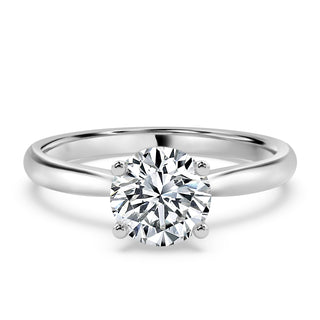
Diamond Quality
The 4 Cs of diamonds provide an objective means to measure and assess a diamond's quality. Without these four parameters, it would be challenging to quantify the quality of a diamond. Unscrupulous vendors could easily claim that a diamond is of high quality and overcharge customers.
With the 4 Cs, consumers have a more objective guide to distinguish between high and low-quality diamonds. Each 'C' offers a quantifiable description of quality in specific areas, making it easier to determine whether a diamond's price is justified.
Buying an Engagement Ring Using the 4 Cs
When purchasing a diamond for an engagement ring, you need to address two key questions: Where and what. We've dedicated an article to guide you on where to purchase your engagement ring. In this article, we focus on the essential characteristics to consider when buying a diamond.
Failure to strike the right balance between the 4 Cs can lead to overpayment for certain diamond qualities while neglecting others. For instance, if you're contemplating a one-carat diamond, achieving the right balance among the 4 Cs can help you obtain a stunning diamond that offers excellent value.
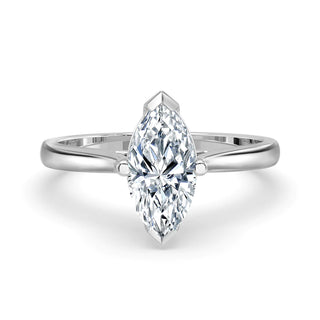
Cut
The 'Cut' stands out as the paramount factor that influences a diamond's quality, significantly impacting its beauty. The diamond's cut specifically pertains to its angles, proportions, symmetrical facets, brilliance, fire, scintillation, and finishing details. These aspects directly affect the diamond's ability to sparkle and its overall aesthetic appeal. For instance, a well-cut diamond radiates with brilliance, while a poorly cut one falls short in this regard.
The GIA classifies diamond cuts on a scale that includes Ideal, Excellent, Very Good, Good, Fair, and Poor. Ideal and Excellent grades, contingent on the diamond's shape, signify proportions and angles optimized for maximum brilliance and fire.
It's important to note that even if two diamonds receive the same grade on the diamond cut chart, the quality of cuts may differ considerably between diamonds and diamond cutters. Sometimes, a cutter may prioritize maximum carat weight, leading to a diamond that is either too deep or too shallow, impeding optimal light reflection. In other cases, a diamond may be cut to reduce inclusions, enhancing its clarity but sacrificing sparkle. In rare instances, even an Ideal cut diamond may exhibit a noticeable yellow tint, detracting from its overall beauty.
What's more, it's crucial to emphasize the paramount role of cut in your diamond selection. Even a pristine 2-carat diamond free from blemishes or color tint can appear dull if not cut with exceptional precision. Cut reigns as the most significant determinant of beauty, taking precedence over the other 'Cs'.
It's essential to understand that a top-grade designation on the diamond cut chart, such as 'Excellent,' doesn't automatically signify an outstanding diamond cut. Nearly 55% of all diamonds sold online boast Excellent cuts, with varying degrees of quality.
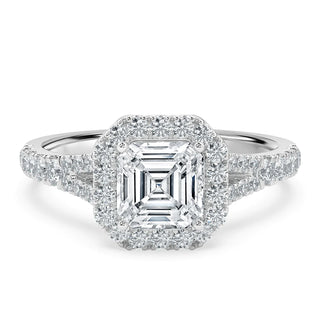
Color
The color of a diamond is evaluated in terms of how white or colorless it appears. The GIA assigns diamond color grades from D (most colorless) to Z (noticeable brown or yellow tint). The appearance of color can vary based on the diamond's cut, carat weight, and shape, making individual assessment critical. The pricing of diamonds typically aligns with their color grade, sometimes resulting in significant price differences.
The key consideration regarding color is whether it appears colorless within its setting. It's imperative to ensure that the diamond is devoid of any tint that diminishes or interferes with the reflection of white and colored light. Diamond brilliance primarily results from the diamond's cut.
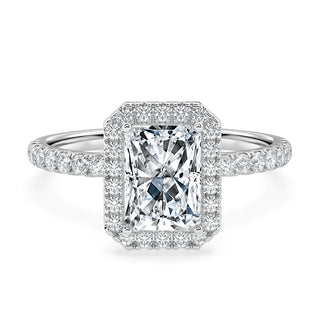
Clarity
A diamond's clarity grade gauges its freedom from both inclusions and blemishes. The GIA employs the following diamond clarity chart:
- FL (Flawless)
- IF (Internally Flawless)
- VVS1 (Very, Very Slightly Included 1)
- VVS2 (Very, Very Slightly Included 2)
- VS1 (Very Slightly Included 1)
- VS2 (Very Slightly Included 2)
- SI1 (Slightly Included 1)
- SI2 (Slightly Included 2)
- I1 (Inclusions 1)
- I2 (Inclusions 2)
It's important to recognize that each diamond possesses unique characteristics. Instead of rigidly adhering to a specific grade on the diamond clarity chart, it's advisable to scrutinize each diamond individually for imperfections.
As you move across the diamond clarity chart, you'll observe a progressive increase in the visibility of inclusions and blemishes. However, not all imperfections are discernible to the naked eye. This is why individual evaluation of each diamond is crucial. These imperfections can obstruct the passage of light through the diamond, diminishing its brilliance and beauty.
For clarity, our primary recommendation is to ensure the diamond is "eye clean," with inclusions that do not hinder light reflection.
It's essential to assess the stone for eye cleanliness and seek affirmation from an expert.
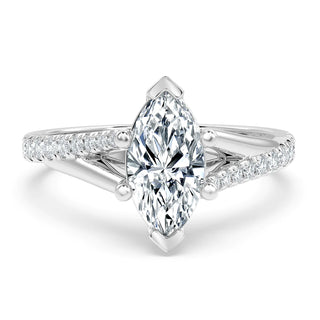
Carat Weight
Carat weight is often equated with a diamond's size, but it specifically measures the diamond's weight, not its physical dimensions. A 1-carat diamond, for instance, weighs approximately 200 milligrams, or 0.2 grams, equivalent to a quarter of a raisin. The actual size of a diamond can differ significantly depending on its shape and cut.
While carat weight plays a role in diamond selection, the overall appearance and brilliance should assume greater importance. For instance, a lackluster 1.5-carat diamond may fail to captivate attention as effectively as a dazzling 1.0-carat diamond, regardless of the former's heavier weight. Rather than fixating on a specific carat weight, it's advisable to prioritize diamonds with an Excellent or Ideal cut, in the shape that aligns with your preferences.
How the 4 Cs Interact
Each of the 4 Cs contributes to the overall beauty of a diamond, rendering each stone unique. It's essential to perceive a diamond as an integrated whole since the human eye struggles to isolate individual diamond characteristics such as clarity or color. Therefore, it's vital to consider the interplay of the 4 Cs.
Which is the most important of the four Cs?
Cut holds the utmost significance among all diamond characteristics as it exerts the most direct influence on a diamond's beauty. Prioritize diamonds with high brilliance and fire, and be prepared to allocate less of your budget to other aspects like clarity or color to secure an outstanding cut.
While most people are familiar with the 4 Cs – Cut, Color, Clarity, and Carat – some introduce a fifth "C" for Certification. The most trusted diamond certifications come from organizations like the GIA and AGS due to their consistent grading in aspects such as color, clarity, and cut quality. These labs are known for rigorous grading compared to other entities.


